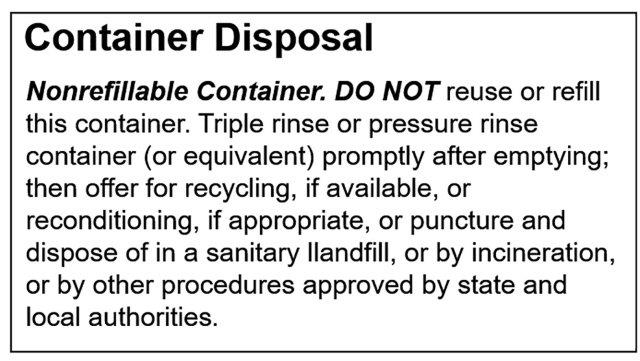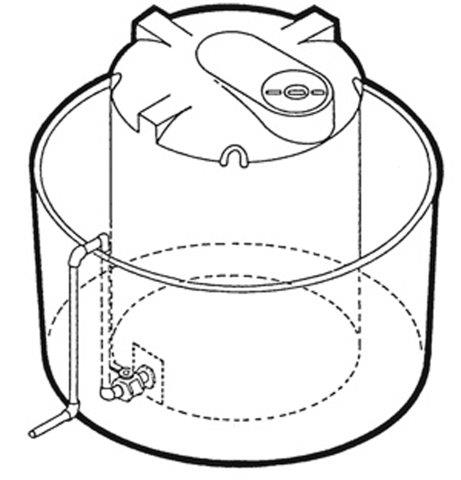G2033 Index: Pesticides, Pesticides General


Greg J. Puckett, Extension Associate
Erin C. Bauer, Entomology Lecturer
Jennifer M. Weisbrod, Assistant Extension Educator
This NebGuide examines the rules and regulations in Nebraska concerning pesticide containers, pesticide repackaging, and secondary containment of bulk agricultural pesticides and fertilizers.
The US Environmental Protection Agency (EPA) Pesticide Container and Containment (PCC) Rule is intended to ensure that containers are strong and durable and that cross-contamination or other problems do not occur. The PCC Rule aims to minimize human pesticide exposure while handling containers, facilitate pesticide container disposal and recycling, and protect the environment from pesticide spills, leaks, or other accidents at bulk storage sites during the pesticide repackaging or dispensing process. The PCC Rule may apply to you if you are a pesticide registrant, refiller, distributor, retailer, commercial applicator, custom blender, or end user.
EPA pesticide container rules apply to nonrefillable and refillable containers, including the repackaging of pesticides in refillable containers. The PCC Rule also addresses labeling on pesticide containers, including requirements for cleaning and disposing of empty containers.
Registrants, formulators, distributors, and dealers are responsible for ensuring that their nonrefillables meet standards. EPA’s publication A Snapshot of the EPA Container and Containment Rule (2009) explains that for products that are not restricted-use, and are in Toxicity Categories III and IV, containers must:
Packaging for all other products (Restricted Use Pesticides (RUP) and/or Toxicity Categories I or II) must meet the nonrefillable container requirements. Nonrefillables must:
Labels on nonrefillable containers identify them as nonrefillable with a “Do not reuse or refill” statement. The label also contains cleaning/rinsing and disposal instructions, recycling instructions (Figure 1), and a lot number identifying the batch.

Figure 1. Example of label language on a nonrefillable container.
Registrants and independent refillers (those who repackage but do not register the product) must comply with requirements for (1) the design and construction of refillable containers, and (2) the repackaging of pesticide products in refillable containers (Figure 2).

Figure 2. Example of label language on a refillable container.
Stationary containers are fixed in place or otherwise remain at a single facility or establishment for 30 or more days, holding pesticides the entire time. When designed to hold 500 or more gallons of liquid pesticides, or 4,000 or more pounds of dry pesticides, these containers require:
In addition, if a stationary container of this design holds agricultural pesticides, it must be held in a secondary containment unit. Secondary containment units have their own design requirements.
Portable refillable containers include mini bulks, shuttles, and totes. Registrants are responsible for making sure these containers meet DOT standards and bear a DOT transport marking and serial number. Every opening on these containers (excluding vents) must be equipped with either a one-way valve, a tamper-evident device, or both.
These changes have resulted in many older containers being recycled. Tri-Rinse, Inc. and many other agrichemical manufacturers or distributors offer programs to properly collect and destroy old mini-bulk containers that can no longer be used under the PCC Rule. Many of these programs will continue for years as old containers are removed from circulation and replaced by new, compliant containers. In Nebraska, Tri-Rinse will collect containers annually, biannually, or as requested. For more information, see www.tri-rinse.com/.
A pesticide product’s registrant may allow independent refillers to repackage their product into refillable containers for distribution or sale. Both the registrant and refiller are responsible for ensuring product integrity (i.e., not altering the formulation). The two parties must enter into a written contract, and the registrant must provide the following documents to the refiller, who must keep them on file:
There are no regulatory limits on the size of refillable containers, but the registrant may establish size limitations in their contract with the refiller.
A refiller must be registered with the EPA as a “producing establishment.” During the repackaging process, refillers need to meet certain requirements, including:
Large containers of bulk liquid fertilizers or pesticides pose some unique challenges, such as the potential for spillage or leakage into groundwater or surface water. To address these issues, there are secondary containment and load-out facility standards covered by the EPA containment rules and Nebraska Title 198, Rules and Regulations Pertaining to Agricultural Chemical Containment. These rules apply specifically to agricultural pesticides and liquid fertilizers. According to Title 198, which is administered by the Nebraska Department of Environment and Energy (NDEE), secondary containment is “a device or structure designed, constructed, and maintained to hold or confine a release of a liquid pesticide or liquid fertilizer from a storage facility.” Simply stated, this means using a larger container to hold a smaller container in order to prevent leakage (Figure 3).
Also, a load-out facility (Figure 4) is defined as “a location, other than the field of application, used for the loading, unloading, handling, or mixing of pesticides or fertilizers or a location used for the rinsing or washing of delivery or application equipment which is designed, constructed, and maintained to hold or confine a release of a liquid pesticide or liquid fertilizer.” For more detailed information about rules pertaining to size, capacity, enclosed or not enclosed, and other aspects of secondary containment and load-out facilities, see the full Title 198 rule at http://deq.ne.gov/RuleAndR.nsf/Title_198.xsp.
Liquid pesticides require secondary containment if the total storage capacity of bulk liquid pesticide containers (>55 gallons) at a storage facility exceeds 500 gallons. For example, if a storage facility has four 250-gallon liquid pesticide containers, its total storage capacity is 1,000 gallons, regardless of whether the containers are actually full of product. This facility would therefore require secondary containment.

Figure 3. Secondary containment.
Dry pesticides require secondary containment when 4,000 or more pounds of undivided product are held in an individual container.
Liquid fertilizers require secondary containment if:
Secondary containment is not required if the contents of one or more containers (up to 6,000 gallons total) are stored at the application site between March 15 and October 1 for no more than 21 consecutive days. Note that this exception is specific to application sites, and some containers, such as those used in chemigation, do not qualify for this exemption. Containers must also follow other rules, including maintaining a minimum distance from wells and surface water.
A load-out facility is required whenever liquid pesticides or fertilizers require secondary containment, as well as when:

Figure 4. A load-out pad.
An exception: a load-out facility is not required when all load-out activities (loading, mixing, rinsing, etc.) are conducted at the application site as part of the normal application. For more information about containment rules and/or exceptions, consult the NDEE publication Fertilizer and Pesticide Containment in Nebraska (see Resources).
While Title 198 does not require either registration or a permit, you must have a construction plan and management program for secondary containment and load-out facilities. The construction plans must be certified by a Nebraska registered professional engineer. These plans remain with the owner and must be made available to NDEE upon request.
Containment standards follow existing NDEE regulations. For guidance contact the NDEE at (402) 471–2186 or visit them at http://deq.ne.gov/.
Fertilizer and Pesticide Containment in Nebraska, 2004, Nebraska Department of Environment and Energy. http://www.deq.state.ne.us/. Search for publication title.
Title 198: Rules And Regulations Pertaining To Agricultural Chemical Containment, Nebraska Department of Environment and Energy. http://deq.ne.gov/RuleAndR.nsf/Title_198.xsp.
A snapshot of the EPA Pesticide Container and Containment Rule, Environmental Protection Agency, 2009. https://www.epa.gov/pesticide-worker-safety/snapshot-epa-pesticide-container-and-containment-rule.
40 CFR Part 165: Pesticide Management and Disposal, Environmental Protection Agency. https://www.ecfr.gov/current/title-40/chapter-I/subchapter-E/part-165.
This publication has been peer reviewed.
Nebraska Extension publications are available online at http://extension.unl.edu/publications.
Extension is a Division of the Institute of Agriculture and Natural Resources at the University of Nebraska-Lincoln cooperating with the Counties and the United States Department of Agriculture.
University of Nebraska-Lincoln Extension educational programs abide with the nondiscrimination policies of the University of Nebraska-Lincoln and the United States Department of Agriculture.
© 2022, The Board of Regents of the University of Nebraska on behalf of the University of Nebraska-Lincoln. All rights reserved.